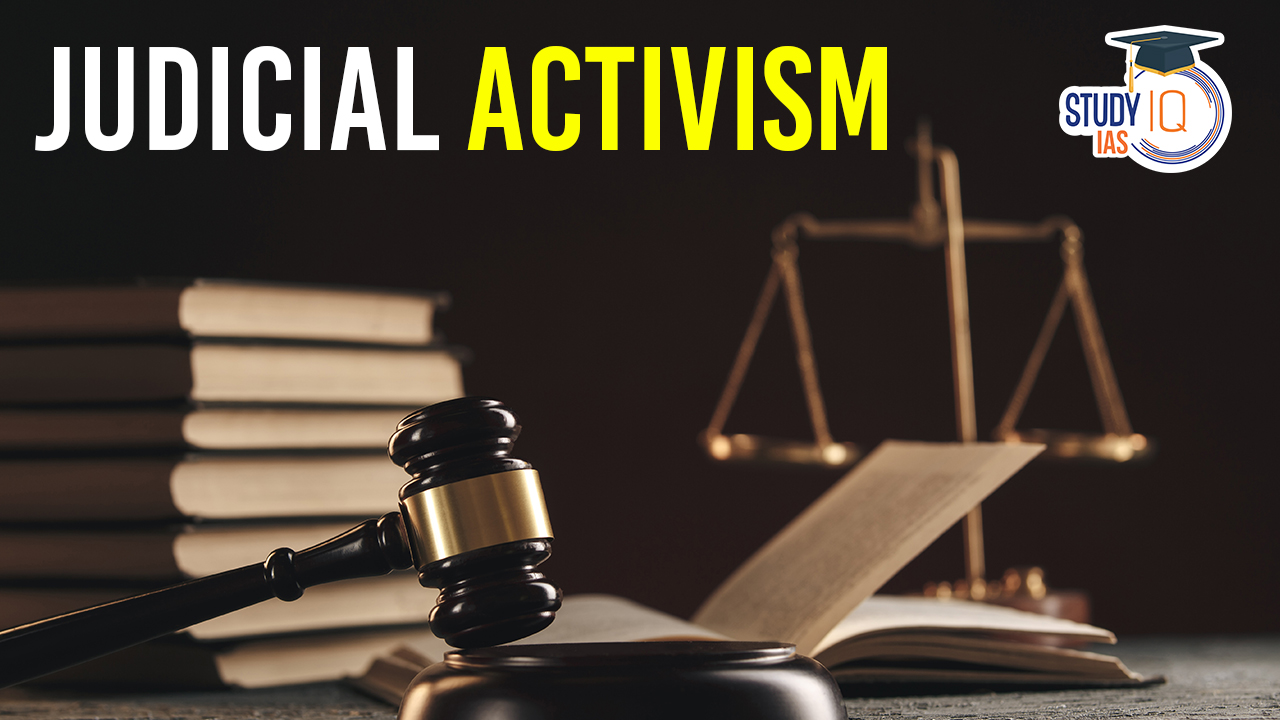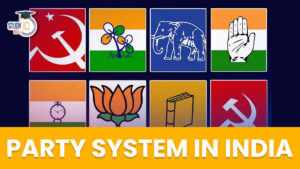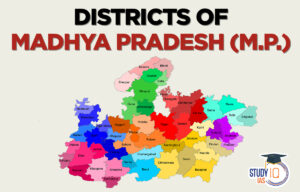Table of Contents
Judicial activism is a term that often sparks intense debates and discussions in legal and political circles. It refers to a proactive role taken by judges in interpreting and applying the law, often going beyond the literal interpretation of statutes to address issues of social justice, individual rights, and public interest. In this article, we will explore the meaning, definition, examples, and the Indian perspective of judicial activism, while also distinguishing it from judicial review.
Judicial Activism
Judicial activism is the practice of courts examining state actions and judicial philosophy that considers broader societal implications beyond the applicable law. It contrasts with judicial restraint, which adheres to original intent, and precedent, and defers policy decisions to the legislature and executive. Some support it for protecting rights and driving change, while others advocate for strict interpretation. An example of judicial activism is the Roe v. Wade decision, which legalized abortion on privacy grounds. In India, justices like V R Krishna Iyer, P N Bhagwati, O Chinnappa Reddy, and D A Desai laid the groundwork for judicial activism, granting the higher judiciary authority to declare legislative, executive, and administrative actions unconstitutional.
We’re now on WhatsApp. Click to Join
Judicial Activism Meaning
Judicial activism is a legal approach where judges actively interpret and apply the law, often going beyond the literal meaning of statutes to address broader societal and ethical implications in their decisions. It involves judges proactively shaping legal and public policy, making decisions that may affect individual rights, minority interests, and social change, even if it means challenging existing laws and government policies. This approach is distinct from judicial restraint, which focuses on a more literal interpretation of the law and a limited role for the judiciary.
Judicial Activism Origin
The concept of judicial activism originated in the United States and was first coined by historian Arthur Schlesinger, Jr. in 1947. It gained prominence in the mid-20th century as American courts, particularly the Supreme Court, took on an increasingly active role in addressing civil rights and social justice issues. Landmark decisions like Brown v. Board of Education and Roe v. Wade exemplified this approach, expanding the scope of judicial authority beyond traditional legal interpretation. In India, judicial activism found its foundation through Justices V. R. Krishna Iyer, P. N. Bhagwati, O. Chinnappa Reddy, and D. A. Desai, who laid the groundwork for a more proactive and socially conscious judiciary, granting it the authority to declare government actions unconstitutional.
Judicial Activism Definition
Judicial activism involves judicial review to invalidate government actions and encompasses several definitions:
- Using the courts to scrutinize state actions,
- Expanding individual rights by departing from established precedents
- Allowing personal policy views to influence decisions.
It transpires when courts actively shape social, economic, or political policies, often interpreting laws and the Constitution liberally to achieve what they see as just outcomes. The term typically conveys criticism of excessive judicial review, though consensus on what qualifies as undesirable remains elusive, as perceptions vary widely on which instances warrant criticism or approval.
Judicial Activism in India
The Indian Constitution places the onus on the State to ensure justice, liberty, equality, and fraternity and protect individuals’ fundamental rights and implement the Directive Principles of State Policy. To prevent the State from evading these responsibilities, the Constitution grants the courts inherent powers to review its actions. The Indian judiciary is regarded as the guardian of the Constitution, actively safeguarding individuals’ fundamental rights against unjust state actions. Judicial activism, as per Black’s Law Dictionary, is when judges use personal views, sometimes disregarding precedent, to guide decisions in interpreting public policy.
Constitutional Powers of the Supreme Court and High Courts in India
| Constitutional Powers | Supreme Court | High Courts |
| Judicial Review | Article 13 with Articles 32 and 226 empower judicial review to declare state actions void if in contravention with the Constitution. | Article 226 grants the power to issue orders or writs for the enforcement of fundamental rights and legal rights. Article 227 provides supervisory control over subordinate courts and tribunals. |
| Enforcement of Fundamental Rights | Article 32 allows individuals to directly seek the Supreme Court to enforce their fundamental rights. | Wider jurisdiction under Article 226 empowers High Courts to enforce fundamental rights. |
| Special Leave to Appeal | Article 136 allows the Supreme Court to grant special leave to appeal from judgments, decrees, or orders in exceptional cases where gross injustice or significant legal questions are involved. | – |
| Curative Petition | Introduced by the judiciary to prevent abuse of process or rectify gross miscarriages of justice. | – |
| Article 142 | Empowers the Supreme Court to pass suitable decrees or orders to achieve complete justice, essentially granting legislative powers, but this is exercised when there is a legislative vacuum. | – |
| Law Declaration | The Supreme Court’s guidelines or directions under Article 142 remain in force until replaced by proper legislation by the Parliament. | – |
| Vishaka Guidelines | The Supreme Court issued guidelines under Article 32 when no legislation existed, which remained in force until replaced by the Sexual Harassment of Women at Workplace (Prevention, Prohibition, and Redressal) Act in 2013. | – |
Transition from Locus Standi to PIL in India
The transition from “locus standi” to “public interest litigation” in India has broadened access to justice. The Indian judiciary recognizes it as a fundamental right, enabling marginalized and disadvantaged individuals to seek justice. This shift emphasizes a more participatory and democratic approach, allowing the courts to engage with public issues and protect the rights of those who face barriers to traditional legal recourse.
Landmark cases highlight the significance of this shift:
- Hussainara Khatoon (I) v. State of Bihar: This case emphasized the right to a speedy trial, leading to directives for providing free legal assistance to undertrial prisoners.
- Sheela Barse v. State of Maharashtra: It allowed a letter alleging custodial violence to be treated as a writ petition, showing the court’s willingness to address pressing issues.
- Sunil Batra v. Delhi Administration: The court recognized that technicalities should not hinder the protection of civil liberties, allowing individuals to seek justice through correspondence.
- Municipal Council, Ratlam v. Vardichand: This case emphasized the shift from “locus standi” to a community-oriented approach in public interest litigation.
- C Mehta v. Union of India: The court accepted a petition concerning Ganga River pollution as a public interest matter, directing measures to prevent pollution.
- Parmanand Katara v. Union of India: It allowed a writ petition for immediate medical treatment for accident victims without complex legal procedures.
- P. Gupta v. Union of India: Bar associations gained the right to file writs through public interest litigation, challenging arbitrary transfers of High Court judges.
These cases highlight that public interest litigation aims to ensure justice and redress for those facing barriers to traditional legal avenues, promoting a more inclusive legal system. However, the courts also caution against abusing public interest litigation for frivolous or obstructive purposes. It should be used to effectively address societal concerns and promote justice.
Key Features of Judicial Activism in India
Indian judicial activism encompasses:
- Expansive Interpretation of Fundamental Rights: Courts, especially the Supreme Court, interpret fundamental rights broadly to protect citizens’ liberties, including socio-economic rights.
- Public Interest Litigation (PIL): The introduction of PIL allows citizens and organizations to represent marginalized individuals who can’t access justice, enhancing inclusivity.
- Environmental and Social Justice: Courts address environmental and social issues, evident in cases related to environmental protection, child labor, bonded labor, and marginalized groups’ welfare.
- Overseeing Executive Actions: Courts scrutinize executive actions to ensure transparency and accountability, issuing directives when necessary.
- Guardians of the Constitution: The judiciary sees itself as the Constitution’s guardian, empowered to review and invalidate inconsistent legislative and executive actions.
- Expanding Access to Justice: Judicial activism broadens access to justice for disadvantaged groups, empowering them to assert their rights effectively.
Judicial Activism and Fundamental Rights
In India, the judiciary has played a pivotal role in shaping fundamental rights jurisprudence by interpreting the “right to life and personal liberty” liberally. Landmark Supreme Court judgments have expanded the scope of these rights, including recognizing prisoners’ rights to access the courts, meet their families, and have freedom of speech. The judiciary has also affirmed the right to a healthy environment, applying the Precautionary and Polluter Principles for sustainable development and invoking the doctrine of public trust to protect natural resources.
The right to education, a fundamental right, has been upheld by the Supreme Court. It was declared that the right to education flows directly from the right to life and the dignity of an individual. The state is obligated to provide educational facilities to its citizens. Constitutional amendments and the Right of Children to Free and Compulsory Education Act, of 2009 have reinforced this right.
The judicial intervention has led to government directives for the rehabilitation of children of prostitutes and the prohibition of child labor in circuses to ensure the fundamental right to education. This includes freeing children through raids, providing shelter, and rehabilitation until they reach 18 years of age.
Judicial Activism Vs Judicial Intervention
In India, there has been an ongoing debate about judicial activism and intervention, with Parliament accusing the judiciary of overstepping its constitutional authority. The judiciary’s involvement in various issues has raised concerns about its boundaries. Some notable instances of judicial intervention include:
- Prakash Singh v. Union of India: Petitioners sought directions to ensure the police’s independent functioning, free from pressure, and the separation of investigation from law and order.
- Vineet Narain v. Union of India: The Supreme Court issued directives to enhance transparency and accountability in the Central Bureau of Investigation (CBI).
- Swaraj Abhiyan-(I) v. Union of India & Ors.: The Supreme Court directed the Ministry of Agriculture to update the Drought Management Manual and establish a National Disaster Mitigation Fund. Concerns were raised about budgetary implications and judicial review.
- National Judicial Appointments Commission (NJAC): The Supreme Court declared the NJAC Act and Constitutional Amendment unconstitutional, reinforcing the collegium system for judges’ appointments, emphasizing judicial independence.
The Supreme Court’s involvement in issues like the National Eligibility-cum-Entrance Test (NEET) and reforms in the Board of Control for Cricket in India (BCCI) has also been viewed as judicial intervention by the government.
While recognizing the need for self-regulation, the Supreme Court has emphasized that judges should understand their limits and not encroach on the domains of other state organs. However, it should be noted that judicial activism has played a crucial role in providing legal assistance and enforcing fundamental rights for marginalized groups and individuals.
| Concept | Description | Criticisms |
| Judicial Activism | – Proactive role of the Judiciary in protecting citizens’ rights. | – Controversy over supremacy between Parliament and Supreme Court. |
| – Courts can declare laws unconstitutional if inconsistent with the constitution. | – Potential disturbance of separation of powers and checks and balances. | |
| Judicial Restraint | – Encourages judges to limit the exercise of their own power. | – Should interpret the law and avoid policy-making. |
| – Judges should consider original intent, and precedent, and leave policy-making to others. | – Promotes adherence to the constitution and legal precedents. | |
| Judicial Overreach | – Occurs when Judicial Activism becomes excessive, interfering with legislative and executive functions. | – Breaches the principle of separation of powers. |
| – Seen as undesirable in a democracy, especially when the judiciary oversteps its role. | – Judiciary argues it steps in when the legislature or executive fails in its functions. |
Judicial Activism Examples
| Case/Example | Country | Description |
| Brown v. Board of Education | United States | U.S. Supreme Court’s decision that declared racial segregation in public schools unconstitutional. |
| Roe v. Wade | United States | U.S. Supreme Court’s decision recognizing a woman’s constitutional right to choose to have an abortion. |
| Kesavananda Bharati v. State of Kerala | India | Indian Supreme Court’s introduction of the “basic structure” doctrine, allowing the review of constitutional amendments. |
| South Africa’s Constitutional Court | South Africa | The Constitutional Court’s role in interpreting and enforcing South Africa’s post-apartheid constitution. |
| Environmental Protection Cases | India | Indian courts’ proactive role in addressing environmental issues through public interest litigation (PIL). |
| Supreme Court of Canada | Canada | The Canadian Supreme Court’s active interpretation of the Charter of Rights and Freedoms, expanding rights in various areas. |
| European Court of Human Rights | Europe | The European Court of Human Rights’ rulings on human rights issues across Europe. |
| Marriage Equality Decisions | Various Countries | Courts’ decisions to legalize same-sex marriage, expanding marriage equality rights. |
Judicial Activism vs Judicial Review
| Judicial Review | Judicial Activism | |
| Definition | Doctrine where Legislative and Executive actions are subject to review by the Judiciary. | Philosophy of judges allowing personal views on public policy rather than strict constitutionalism. |
| Classification | 1) Review of Legislative Actions; 2) Review of Judicial Decisions; 3) Review of Administrative Action. | Examples: Golaknath case, Kesavananda Bharati, SC’s supervisory role in CBI investigation, invoking terror laws. |
| Purpose | Ensure legislative actions comply with the Constitution. | Judges consider personal views on public policy. |
| Role of Courts | Ensuring laws passed by the Legislature align with the Constitution. | Judges may reshape laws according to their views on public policy. |
| Limits | Limited to procedural correctness, can’t interfere with policy decisions. | Personal opinions may lead to rewriting laws, potentially breaching separation of powers. |
| Scope | Mainly concerns legality, limited power to interfere in policy decisions. | Behavioral concept, based on public interest and expediency. |
| Authority | Superior courts (Supreme Court and High Courts). | Relies on the judge’s personal views. |
| Temporariness | Temporary until legislation is enacted, can’t make laws. | Potentially ongoing influence on law interpretation and decision-making. |
| Public Involvement | Generally, courts review without executive or legislative direction. | Judges may take an activist approach based on their interpretation of public interest. |
| Balance of Power | Ensures the balance between the branches of government. | May disrupt the traditional balance of powers and separation of powers. |
| Importance | Guarantees constitutionality and safeguards fundamental rights. | May protect marginalized voices and ensure justice, but could lead to judicial overreach. |
Judicial Activism UPSC
Judicial activism refers to a proactive role taken by judges in interpreting and applying the law, often going beyond literal statutory interpretation to address broader issues of social justice, individual rights, and public interest. In India, the Constitution grants the judiciary the authority to review legislative, executive, and administrative actions, making it a guardian of fundamental rights. It has expanded access to justice, protected the environment, and overseen executive actions. However, judicial activism has faced criticism for potentially disrupting the separation of powers. In contrast, judicial review is a legal doctrine focused on ensuring government actions comply with the constitution, without judges actively shaping public policy.


 Party System in India, Feature, Importan...
Party System in India, Feature, Importan...
 Consolidated Fund of India, Meaning and ...
Consolidated Fund of India, Meaning and ...
 Districts of MP List, Name, Importance, ...
Districts of MP List, Name, Importance, ...





















